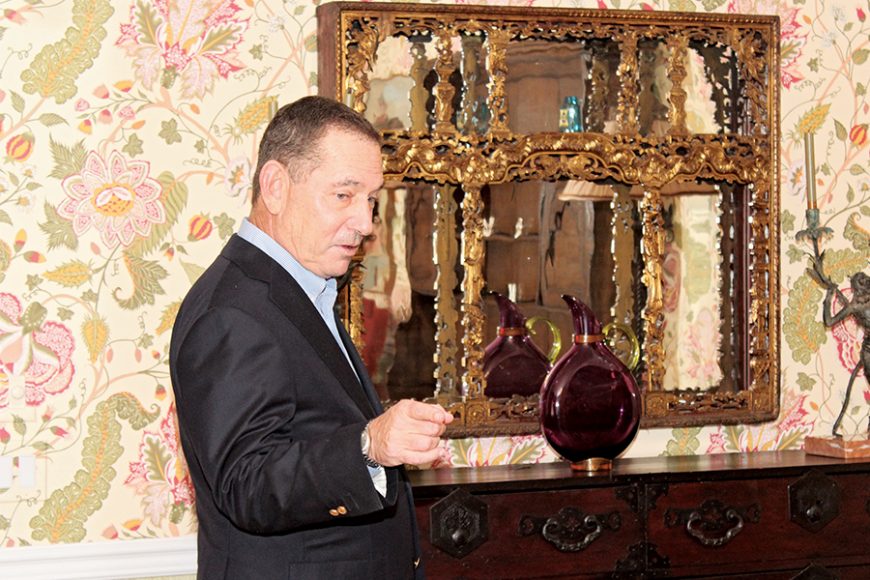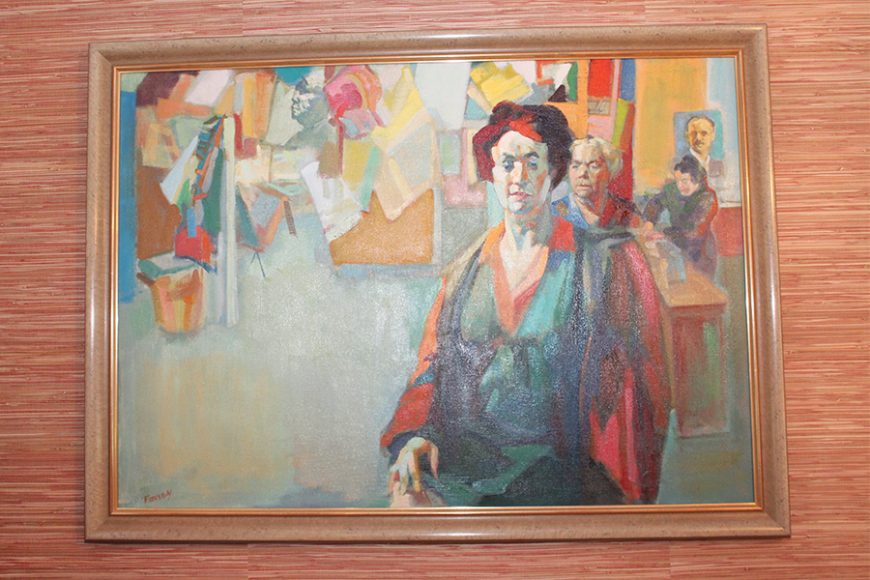Yale Paprin, president of Yale Realty Services Corp., is a man of passion.
You can hear it in the authoritative way he expresses his opinions. You may not always agree with them, but you can’t deny either his right to express them or the knowledge and feeling with which he expresses them.
The late Cortlandt Manor resident Aaron Copland and his protégé Leonard Bernstein were “by far” the best American composers of the 20th century, he says. The Neuberger Museum of Art in Purchase, where he’s “very excited” to be the newest member of the board of trustees, is “one of the greatest hidden gems among the satellite art galleries.” Eric Aho, the abstract landscape painter, “is the single best artist in my mind. He will get his recognition when I’m done,” Paprin says.
He’s already made good on that. Not only does he own a number of Ahos — including the springy, splashy “The Beekeepers,” a burst of effervescent greens and yellows dominating a wall opposite his imposing staircase gallery; and the riparian “Spanish Guest” — but he donated the funds for the Neuberger to buy one from the DC Moore Gallery, which represents Aho.
“I said to (Neuberger chief curator) Helaine (Posner), ‘Would the Neuberger like to own an Aho?’ She (and director Tracy Fitzpatrick) went to the DC Moore Gallery and picked one out.”
The one is “Approach” (2012), an oil on linen that drips with peachy pinks, summer-sky blues and lemony yellows.
We’re talking in the living room of Paprin’s home not far from his West Harrison business. Actually, it’s more like we’re verbally serving and volleying, as Paprin counts among his other avocations playing tennis and golf, road cycling, mountain hiking and attending the symphony. Mozart’s Symphony No. 25 in G minor — whose insistent opening drives the beginning of the 1984 film “Amadeus” — wafts through the elegant-yet-comfortable house, which offers a surprisingly traditional yin to the art’s Modernist and contemporary yang. The living room and the dining room — with its stunning red-and-green chinoiserie wallpaper and Portuguese rug — were decorated by style icon Iris Apfel, a friend of the family who did Paprin’s previous home in Chappaqua, where he lived for 34 years. Though Paprin did not study art in school — he majored in political science at Case Western Reserve University in Cleveland after growing up in Great Neck on Long Island — he has a background that ideally suited him to collecting, a mother who was interested in interior design and a father who was in real estate.
“You have an inherent interest in art and decorating when you grow up with it,” he says. “If you want your child to be interested in Beethoven, then he has to grow up listening to Beethoven.”
Early influences included his father’s oldest friend, former garment manufacturer and now centenarian Charles Zitner, whose tastes for “darker, haunting pieces” influenced Paprin’s interest in the Surrealist Odilon Redon.
Like himself, many of the biggest collectors are in real estate, he adds. Not only do investors and developers have spaces to fill, but they have the money with which to fill them. Among Paprin’s role models was Ian Woodner, the artist- and architect-trained developer who amassed a collection of Old Master drawings and other exhibited works that at the time of his death in 1990, Paprin says, was probably worth more than his real estate holdings. Woodner told him that he didn’t need a background in art: “You have an eye. Keep buying. Buy till it hurts.”
Paprin, who started collecting posters while still in school, seems to have heeded that advice. The house is graced by art in virtually every room, mostly paintings and works on paper from the 19th through 21st centuries but also a few sculptures like a graceful female Regency head; Jacques Lipchitz’s “Tête,” another, modern head; and Chaim Gross’ small, sensuous “Woman Lying on Her Side in Sleep.” There are also drawings by Henri Matisse and Pablo Picasso; Maurice Denis’ fin de siècle “La Visitation,” about Elizabeth and the Virgin Mary; an empty space awaiting a Faith Ringgold, outsider art by William Hawkins upstairs; and a blowup of Joel Meyerowitz’s “Dairyland, Provincetown” in the kitchen from his seminal, autographed 1976 book of photographs “Cape Light.”
The place is an art lover’s treasure hunt, but what really makes it so is Paprin’s gift for storytelling. Take the work that hangs over the fireplace — Jacob Lawrence’s “The Swearing In,” its colorful block figures echoing many of Paprin’s favorite artists, including Milton Avery, whose paintings were a centerpiece of the Roy R. Neuberger collection that is the foundation of the Neuberger Museum.
The Lawrence work, he says, was commissioned by President Jimmy Carter’s Inauguration Committee, which sold posters and T-shirts of the work — showing the American everyman and everywoman focused on the event amid the skeletal landscape of Washington D.C. in January — to pay for the inauguration. Yet there above the fireplace is the original.
Though Paprin says everyone has his price limit and has sold three works of what he calls inferior quality to buy the Ringgold, he doesn’t collect art as an investment. He points to
Picasso’s linocut of a face called “Yo Picasso” that sits on a shelf in his study. For the $500 he paid for it in 1983, he says, he would’ve been better off investing the money in the S & P.
But that’s not the point for Paprin. It comes back to passion.
“You can’t be taught that,” he says. “You either have it or you don’t.”
And Paprin has it.







Wonderful!